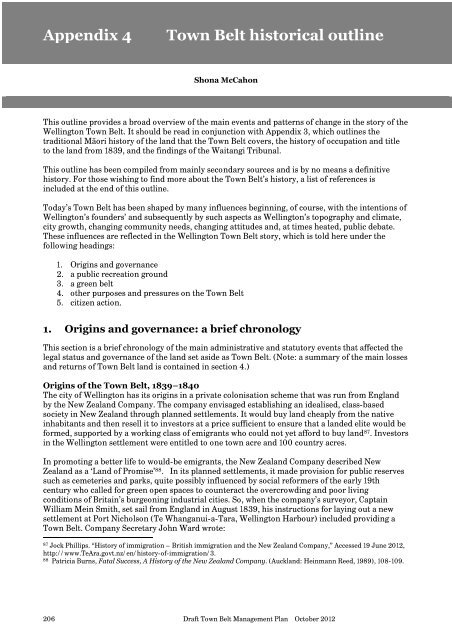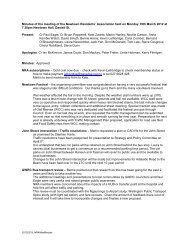Draft Town Belt Management Plan - Wellington City Council
Draft Town Belt Management Plan - Wellington City Council
Draft Town Belt Management Plan - Wellington City Council
Create successful ePaper yourself
Turn your PDF publications into a flip-book with our unique Google optimized e-Paper software.
Appendix 4 <strong>Town</strong> <strong>Belt</strong> historical outline<br />
206<br />
Shona McCahon<br />
This outline provides a broad overview of the main events and patterns of change in the story of the<br />
<strong>Wellington</strong> <strong>Town</strong> <strong>Belt</strong>. It should be read in conjunction with Appendix 3, which outlines the<br />
traditional Māori history of the land that the <strong>Town</strong> <strong>Belt</strong> covers, the history of occupation and title<br />
to the land from 1839, and the findings of the Waitangi Tribunal.<br />
This outline has been compiled from mainly secondary sources and is by no means a definitive<br />
history. For those wishing to find more about the <strong>Town</strong> <strong>Belt</strong>’s history, a list of references is<br />
included at the end of this outline.<br />
Today’s <strong>Town</strong> <strong>Belt</strong> has been shaped by many influences beginning, of course, with the intentions of<br />
<strong>Wellington</strong>’s founders’ and subsequently by such aspects as <strong>Wellington</strong>’s topography and climate,<br />
city growth, changing community needs, changing attitudes and, at times heated, public debate.<br />
These influences are reflected in the <strong>Wellington</strong> <strong>Town</strong> <strong>Belt</strong> story, which is told here under the<br />
following headings:<br />
1. Origins and governance<br />
2. a public recreation ground<br />
3. a green belt<br />
4. other purposes and pressures on the <strong>Town</strong> <strong>Belt</strong><br />
5. citizen action.<br />
1. Origins and governance: a brief chronology<br />
This section is a brief chronology of the main administrative and statutory events that affected the<br />
legal status and governance of the land set aside as <strong>Town</strong> <strong>Belt</strong>. (Note: a summary of the main losses<br />
and returns of <strong>Town</strong> <strong>Belt</strong> land is contained in section 4.)<br />
Origins of the <strong>Town</strong> <strong>Belt</strong>, 1839–1840<br />
The city of <strong>Wellington</strong> has its origins in a private colonisation scheme that was run from England<br />
by the New Zealand Company. The company envisaged establishing an idealised, class-based<br />
society in New Zealand through planned settlements. It would buy land cheaply from the native<br />
inhabitants and then resell it to investors at a price sufficient to ensure that a landed elite would be<br />
formed, supported by a working class of emigrants who could not yet afford to buy land 87 . Investors<br />
in the <strong>Wellington</strong> settlement were entitled to one town acre and 100 country acres.<br />
In promoting a better life to would-be emigrants, the New Zealand Company described New<br />
Zealand as a ‘Land of Promise’ 88 . In its planned settlements, it made provision for public reserves<br />
such as cemeteries and parks, quite possibly influenced by social reformers of the early 19th<br />
century who called for green open spaces to counteract the overcrowding and poor living<br />
conditions of Britain’s burgeoning industrial cities. So, when the company’s surveyor, Captain<br />
William Mein Smith, set sail from England in August 1839, his instructions for laying out a new<br />
settlement at Port Nicholson (Te Whanganui-a-Tara, <strong>Wellington</strong> Harbour) included providing a<br />
<strong>Town</strong> <strong>Belt</strong>. Company Secretary John Ward wrote:<br />
87 Jock Phillips. “History of immigration – British immigration and the New Zealand Company,” Accessed 19 June 2012,<br />
http://www.TeAra.govt.nz/en/history-of-immigration/3.<br />
88 Patricia Burns, Fatal Success, A History of the New Zealand Company. (Auckland: Heinmann Reed, 1989), 108-109.<br />
<strong>Draft</strong> <strong>Town</strong> <strong>Belt</strong> <strong>Management</strong> <strong>Plan</strong> October 2012





